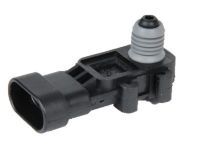My Garage
My Account
Cart
Genuine Chevrolet K1500 Fuel Pressure Sensor
Fuel Tank Pressure Sensor- Select Vehicle by Model
- Select Vehicle by VIN
Select Vehicle by Model
orMake
Model
Year
Select Vehicle by VIN
For the most accurate results, select vehicle by your VIN (Vehicle Identification Number).
3 Fuel Pressure Sensors found
Chevrolet K1500 Sensor,Fuel Tank Pressure
Part Number: 16238399$48.12 MSRP: $101.06You Save: $52.94 (53%)Ships in 1-2 Business DaysChevrolet K1500 Sensor Asm,Water In Fuel Indicator
Part Number: 12375515$128.22 MSRP: $233.12You Save: $104.90 (45%)Ships in 1-2 Business Days
Chevrolet K1500 Fuel Pressure Sensor
This pressure transmits to the engine control unit, which in turn interprets it and in the case of Chevrolet K1500, the vehicle uses a Fuel Pressure Sensor, also called a fuel tank pressure sensor. This information is transferred to the internal computer of the vehicle for adjusting the necessary settings regarding the timing cycle for optimal performance of the vehicle's engine. The type of fuel pressure sensor vary from one K1500 model to another, but the general idea is to make sure the engine receives the correct fuel pressure. There are symptoms that show that a particular sensor is not working properly these are; difficult startups, sluggishness, low fuel economy, the check engine light comes on. The fuel pressure sensor performs a crucial task when it comes to the maintenance of the engine and its functionality, therefore constant check ups on the fuel pressure sensor is advised.
Each OEM Chevrolet K1500 Fuel Pressure Sensor we offer is competitively priced and comes with the assurance of the manufacturer's warranty for the part. Furthermore, we guarantee the speedy delivery of your orders right to your doorstep. Our hassle-free return policy is also in place for your peace of mind.
Chevrolet K1500 Fuel Pressure Sensor Parts Questions & Experts Answers
- Q: What is the role of the fuel evaporative emissions control (EVAP) system,Purge Valve,Fuel Pressure Sensor and Canister on Chevrolet K1500?A: The role of the evaporative emissions control (EVAP) system is to manage fuel vapors by absorbing them from the fuel tank and then releasing into the engine's intake system where they will mix with incoming air/fuel mixture. The canister filled with activated charcoal for vapor absorption, purge valve, vent valve, fuel tank pressure sensor, fuel tank itself, and vapor and purge lines are some of the key components that make up this system though there might be slight variations in their components through different years and applications. The charcoal canister is a sealed carrier entered via a check valve by fuel tank vapor on its way through a second hose comprised of capillary slits which have been called vapor hose in order to let out or activate coal store the vapors. When certain conditions are met for instance; engine running or reaching preset temperature, the ECM/PCM opens both the purge valve as well as vent valve. Consequently, intake manifold vacuum drawn through a purge hose causes fumes from canister while normal engine operation consumes this fumes inside intake manifolds including combustion chambers. The EVAP purge solenoid is modulated by ECM/PCM to control the rate at which vapors flow from the canister to intake manifold. In cold conditions and during a hot start time delay, this solenoid remains de-energized according to ECM/PCEM. After warming up to operating temperature range specified for it, engine control module/ power control module (ECM/PCM) regulates purging of vapors into intake manifold based on engine running conditions. By varying energization time of solenoid OBD II models cycle purge valve control solenoid from 5 to 10 times per second for adjusting a flow rate. In such case PCM opens EVAP canister purge valve and closes vent valve during cold engine startup thereby creating vacuum throughout EVAP system after 1996 -2000 OBD-II models. PCM closes purge valve after reaching vacuum level, sealing the system and monitoring fuel tank pressure sensor voltage to set diagnostic code in case of leak detection. In these models, there is also a fuel tank pressure sensor that sends back a signal voltage to the PCM reflecting air pressure inside the fuel tank for detecting leaks. Of note, this system is protected by a five-year/ 50,000-mile warranty as mandated by federal law. In troubleshooting the system, start by checking hoses for damage, disconnection or misrouting. Repair any faulty hoses or replace them as required. For pre-EVAP controls model years check charcoal canister, purge control valve and vacuum hoses for possible problems. Late models contain electronic purge control so it is important to verify related fuses and wiring integrity pertaining to the purge and vent valves. These valves are typically closed with vapor flow starting following activation of PCM's solenoid. Although some limited testing may be performed, a scan tool must be used for thorough examination. If these initial checks do not identify the problem, consult a dealer service department or qualified repair shop. When replacing components, late model EVAP system hoses are equipped with quick-connect fittings requiring a twisting motion to loosen the seal before disconnection is made. The EVAP canister's location varies with the year and application while its removal involve disconnecting these hoses and removing bracket mounting bolt. During removal of early model vehicles, on top of electrical connector detachment one has to remove connecting lock tab on hose then take away mounting nuts/bolt from its intake manifold place or charcoal canister (Allen 83). On 1996-2000 models vent valve is mounted on bracket close to fuel tank which means raising of vehicle will have to occur since you should disconnect electrical connector from it then remove hose next release retainer in order displace vent valve from bracket (Allen 83). In 1996 through 2000 only, fuel tank pressure sensor is located on the fuel pump module hence removal of fuel tank follows disconnection of electrical connector and then releasing retaining clip to get rid of sensor from the pump (Allen 84). Put all replaced components back in place as we have done in reverse order.














